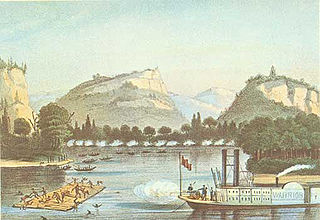
The Mississippi River is the second-longest river and chief river of the second-largest drainage system in North America, second only to the Hudson Bay drainage system. From its traditional source of Lake Itasca in northern Minnesota, it flows generally south for 2,340 miles (3,770 km) to the Mississippi River Delta in the Gulf of Mexico. With its many tributaries, the Mississippi's watershed drains all or parts of 32 U.S. states and two Canadian provinces between the Rocky and Appalachian mountains. The main stem is entirely within the United States; the total drainage basin is 1,151,000 sq mi (2,980,000 km2), of which only about one percent is in Canada. The Mississippi ranks as the thirteenth-largest river by discharge in the world. The river either borders or passes through the states of Minnesota, Wisconsin, Iowa, Illinois, Missouri, Kentucky, Tennessee, Arkansas, Mississippi, and Louisiana.

The Quad Cities is a region of cities in the U.S. states of Iowa and Illinois: Davenport and Bettendorf in southeastern Iowa, and Rock Island, Moline and East Moline in northwestern Illinois. These cities are the center of the Quad Cities metropolitan area, which as of 2013 had a population estimate of 383,781 and a Combined Statistical Area (CSA) population of 474,937, making it the 90th-largest CSA in the nation.

A steamboat is a boat that is propelled primarily by steam power, typically driving propellers or paddlewheels. Steamboats sometimes use the prefix designation SS, S.S. or S/S or PS ; however, these designations are most often used for steamships.
USS Iowa may refer to several vessels:
USS Abeona was a mercantile stern wheel steamer that traded on the Mississippi between 1831 and her destruction by fire in 1872, except for two years, between 1863 and 1865, when she served the United States Navy as a gunboat.

The Grand Excursion was a promotional voyage by train and steamboat into the Upper Mississippi River valley, USA that first took place in June 1854. It marked the first railroad connection between the East Coast and the Mississippi River, and it included dignitaries such as former president Millard Fillmore. In 2004, 150 years later, the Grand Excursion route was retraced by both riverboats and a steam locomotive.

The Illinois Central Railroad, sometimes called the Main Line of Mid-America, was a railroad in the Central United States, with its primary routes connecting Chicago, Illinois, with New Orleans, Louisiana, and Mobile, Alabama. A line also connected Chicago with Sioux City, Iowa (1870). There was a significant branch to Omaha, Nebraska (1899), west of Fort Dodge, Iowa, and another branch reaching Sioux Falls, South Dakota (1877), starting from Cherokee, Iowa. The Sioux Falls branch has been abandoned in its entirety.

The Wheeling Suspension Bridge is a suspension bridge spanning the main channel of the Ohio River at Wheeling, West Virginia. It was the largest suspension bridge in the world from 1849 until 1851. Charles Ellet Jr. designed it and supervised construction of what became the first bridge to span a major river west of the Appalachian mountains. It linked the eastern and western section of the National Road, and became especially strategically important during the American Civil War. Litigation in the United States Supreme Court concerning its obstruction of the new high steamboat smokestacks eventually cleared the way for other bridges, especially needed by expanding railroads. Because this bridge was designed during the horse-and-buggy era, 2-ton weight limits and vehicle separation requirements applied in later years until it was closed to automobile traffic in September 2019.

The Government Bridge or Arsenal Bridge spans the Mississippi River, connecting Rock Island, Illinois and Davenport, Iowa. The Iowa Interstate Railroad uses the upper deck of the bridge for its ex-Chicago and Rock Island Railroad route between Council Bluffs, Iowa and Chicago, Illinois. The lower deck carries automobile traffic between the two cities. It is located near Upper Mississippi Mile Marker 483, adjacent to the Mississippi River Lock and Dam No. 15. The current structure is the fourth at this location. The bridges all were built with a swing section to accommodate traffic navigating the river.

The Clinton Railroad Bridge, also called the Chicago and Northwestern Railway Bridge or more simply the Clinton Bridge, is a bridge that carries double tracked rail lines across the Mississippi River between Clinton, Iowa, and Fulton (Albany), Illinois. The bridge is a truss bridge with a swing span crossing the main river channel and is adjacent to the Gateway Bridge. The original bridge was constructed in 1858, and the first train crossed the bridge on January 19, 1860. The bridge was the second railroad crossing over the Mississippi River, and the first over the Upper Mississippi. In 1870, the bridge was declared a post route, therefore stopping the occupation of steamboats and approval of railroads. From 1859 to 1908, the mileage in operation increased from 28,789 to 229,230, prompting the Chicago and North Western Railway to replace the bridge with a new structure in 1900.

The Anchor Line was a steamboat company that operated a fleet of boats on the Mississippi River between St. Louis, Missouri, and New Orleans, Louisiana, between 1859 and 1898, when it went out of business. It was one of the most well-known, if not successful, pools of steamboats formed on the lower Mississippi River in the decades following the American Civil War.

The La Crosse Rail Bridge is a swing bridge that spans the Mississippi River between La Crescent, Minnesota and La Crosse, Wisconsin. The first bridge in this location initially was designed and ready to build by June 1876, and was completed in November 1876 by the Milwaukee and St. Paul Railway, a predecessor of the Chicago, Milwaukee, St. Paul and Pacific Railroad. It was later replaced in 1902. It is at the Western end of the Canadian Pacific Railway Tomah Subdivision. Amtrak's Empire Builder crosses this bridge.

The Des Moines Rapids between Nauvoo, Illinois and Keokuk, Iowa-Hamilton, Illinois is one of two major rapids on the Mississippi River that limited Steamboat traffic on the river through the early 19th century.

President is a steamboat that currently lies dismantled in Effingham, Illinois. Originally named Cincinnati, it was built in 1924 and is the only remaining "Western Rivers" style sidewheel river excursion steamboat in the United States. She was listed on the National Register of Historic Places and declared a National Historic Landmark in 1989, although these designations were revoked in 2011. Her home ports have been Cincinnati, Ohio; New Orleans, Louisiana; Vicksburg, Mississippi; St. Louis, Missouri; and Davenport, Iowa.

Warrior was a privately owned and constructed steamboat that was pressed into service by the U.S. government during the Black Hawk War to assist with military operations. Warrior was constructed and launched in 1832 at Pittsburgh, Pennsylvania by Joseph Throckmorton who also served as the vessel's captain. Once constructed the vessel traveled to St. Louis and into the war zone. Warrior played a key role in the decisive Battle of Bad Axe. Following the war the steamboat continued its service under Throckmorton along the Upper Mississippi River.

USS St. Clair was a steamer purchased by the Union Navy during the American Civil War.
Hurd v. Rock Island Bridge Company (1857) is a landmark American civil case that won Abraham Lincoln fame as a lawyer.
Horace Ezra Bixby was a steamboat pilot on the Mississippi-Missouri-Ohio river system from the late 1840s until his death in 1912. Bixby is notable in his own right for his high standing in his profession, for his technical contributions to it, and for his service in the American Civil War. However, he is best known for having had as his "cub pilot" the young man known to him as Sam Clemens, later to become famous under his pen name as American author Mark Twain. Twain's descriptions of Bixby's character and pedagogic style form a good part of his memoir Life on the Mississippi, and it was through this medium that Bixby—much to his annoyance—became well-known beyond the circles of his family, friends and profession.
Streckfus Steamers was a company started in 1910 by John Streckfus Sr. (1856–1925) born in Edgington, Illinois. He started a steam packet business in the 1880s, but transitioned his fleet to the river excursion business around the turn of the century. In 1907, he incorporated Streckfus Steamers to raise capital and expand his riverboat excursion business. A few years later, the firm acquired the Diamond Jo Line, a steamboat packet company.
Verne Swain refers to three steamboats built by the Swain Shipyard of Stillwater, Minnesota. Swain built the first one in 1886, the second one in 1904, and the last one in 1913.
















